Who is Magnus Christensson
Magnus is the VP of Product at Lenus eHealth. He’s runnings the Product and Tech organization alongside one of the co-founders Magnus is responsible for Product Management and UX part of that, but in a peer leadership group alongside the co-founder.
Magnus speaks for myself rather than on the behalf of Lenus eHealth. The views I have on product development, product management, and how we run things, is Magnus’ own.
On applying methods and frameworks
When we talk about introducing new things and working in new ways, it’s very dependent on the relations, the context, and the history of that particular organization. Magnus believes that organizations should be seen primarily as dynamic and process-oriented rather than as an instrumental one.
When we look at frameworks we look at models or artifacts: a particular way of doing things. Magnus believes that we must not think that they can be implemented in the same way in every type of organization across the world.
This statement might seem logical when you read it, but still, that’s what we try to come up with best practice make up tools. Obviously, we can see it as inspiration, but we need to try it out to make it work for ourselves. We need to take the relationships within the organizations that we’re actually doing it in, the context we’re in, and the history of that particular organization – into consideration when we try to do stuff differently.
We can only tell how it works for us in retrospect. So we have to do it. We have to try it out. We have to do something in order to reflect on it and understand it. To understand how one thing can work in our organization. To understand how we can change it and adjust it
So, don’t do this at home as I’m telling it. Be inspired to do it in your own way.
About Lenus eHealth and its offering
Lenus eHealth partners with some of the best health and fitness coaches to grow their businesses. In December 2022, Lenus was a company of 420 colleagues of 53 nationalities with nine officers in seven different countries. Lenus is still a young company - 6 years old - so we’ve experienced intentional rapid growth. We have this very strong growth focus, which means that all over the organization, people are actively searching for new opportunities.
The organization and as such, the product, consists of two sides: a technical side, the technical platform that enables coaches to manage clients at scale – and then there’s the commercial platform supporting fitness coaches in their growth journey, encouraging coaches to continuously and sustainably grow their business and their client base. Magnus is primarily working, obviously, in the technical side of things but there’s a close relationship and a close collaboration between the product and the technical side and the commercial side.
The technical product consists of two parts: a client app and iOS and an Android app where clients use the app to communicate and track progress and on the other end, a web-based tool – a coach tool for coaches to manage and plain their work. They do workout planning, pipeline management, and that sort of thing to drive their business forward. That’s what we’re building.
With that in place, we’re ready to speak a little bit about the challenges.
Taking the product market leadership globally
From a product perspective, we are really interested in having a product leadership globally. So we want to take and keep the superior market position targeting the top five percent of coaches globally. The success comes from a very visionary leadership and entrepreneurial leadership from the founder. That context and that history is really important to understand how we worked and how we had to change and adjust the product management and product development to fit that kind of culture even better.
Finding a more reliable way to deliver value and learn quickly
We focused on two different tools or artifacts or waste of thinking about product development and management. One called missions. And one is called cadence.
Missions: Aligning intent with plans, actions, and outcomes
Stephen Bungay’s book, The Art of Action, is one of the main inspirational parts that helped us understand how to better link strategy with operations, while allowing teams to still have autonomy and their own way of working that still fits our culture.
To close the alignment gap, we focus on three things and how they are connected to each other:
- The outcomes we want to achieve
- The plans we make to achieve the outcomes
- The actions we take to make the plans happen and achieve the outcomes
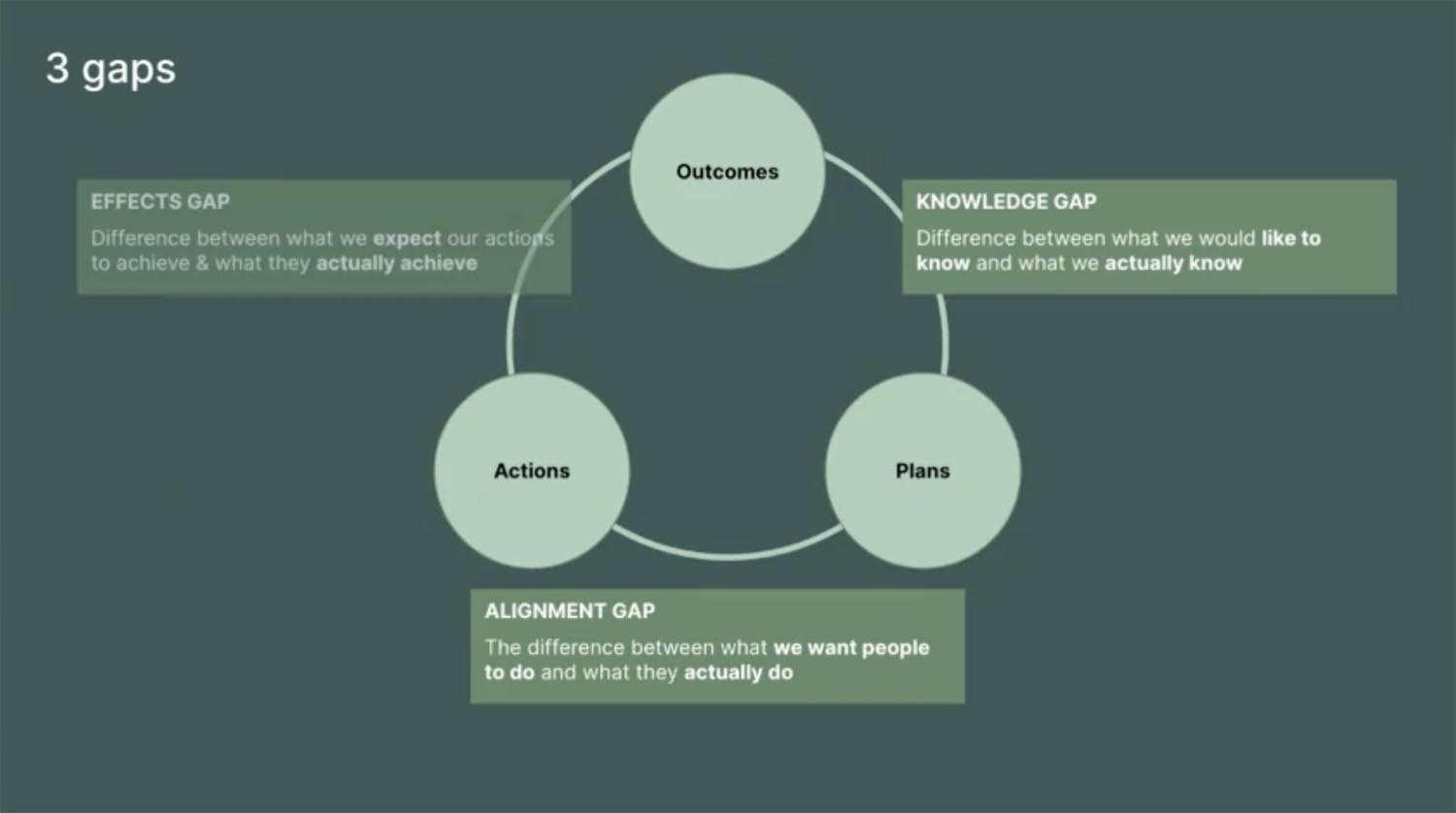
Between each of those three parts, there is the potential of three gaps in alignment and understanding:
- The knowledge gap between what we like to know and what we actually know
- The alignment gap between what we want people to do and what they actually do
- Effects gap between what we expect our actions to achieve and what they actually achieve
These are very natural issues in all organizations. which have some kind of hierarchy and where people know different things at different levels.
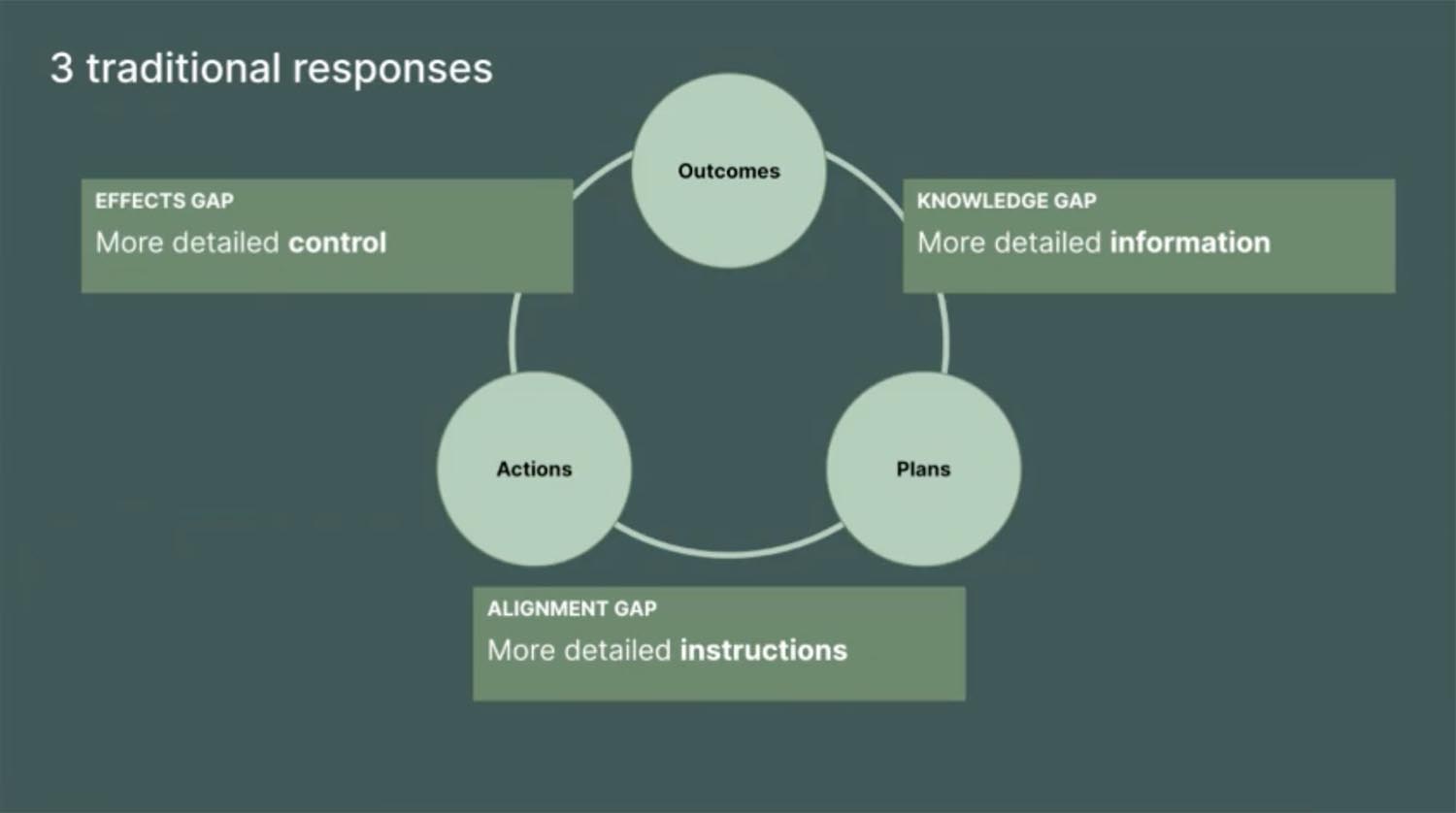
The traditional response is more control. It’s closing the gap by asking for more detailed information to close the knowledge gap. Or giving more detailed instructions of how to do things to close the alignment gap. Or having more detailed control about the effects of what our actions produce to close the effects gap.
Both Steven Bungay’s approach, as the inspiration, but also our own approach at Lenus eHealth, has been a bit different from the traditional approach.

We like to communicate the intent: What are we trying to achieve? We like to talk about how we can align around that, allowing each team to define how they can achieve the intent and articulate “the how” and the back brief - translating intent into plans. And then allow both the teams, but also individuals in the teams, to adjust their actions in line with the intent.
That gives us a very clear idea of what we would like to achieve and helps us ask teams how we can best achieve the intent, allowing them also to adjust as we move forward.
Introducing the concept of Missions and back-briefs

To convert this into something operational, we use the idea and artifacts of a mission and a mission back brief. We use these artifacts to bridge the gaps. The mission explains what we want to accomplish and why it is important to our organization. Missions are both created top down and by teams themselves - in fact, most of the time, missions are proposed by teams, suggesting that we should achieve this and this in this area, but they are prioritized by the leadership.
Back briefs
With a mission in hand, the team produces a back brief describing how we would achieve that particular mission. Back briefs are written by the teams that are about to go on those missions and those that will carry out the work and actually do something about it. Back briefs are written by the people who are about to to work on it.
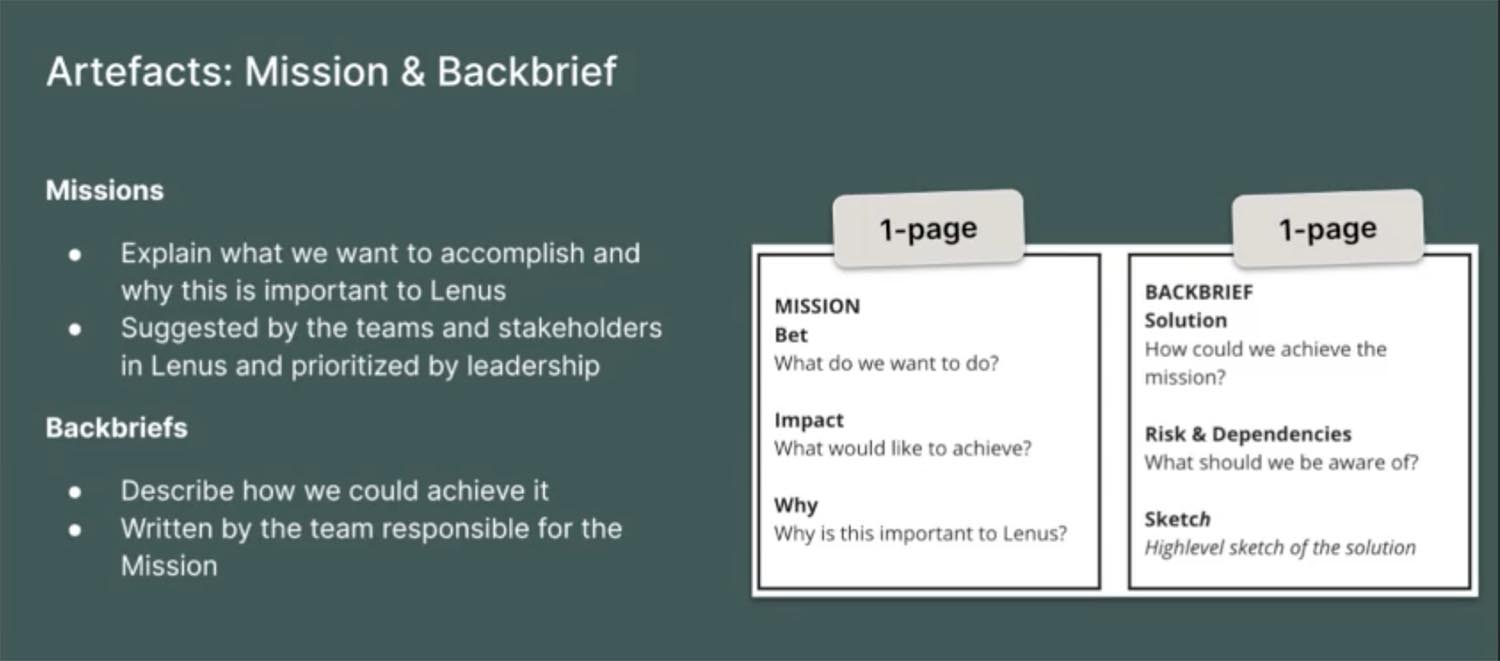
With the help of these artifacts, we try to mitigate the problem of alignning between what we try to achieve and how we like to achieve it and in turn create a handshake between those who create and those who decide - a handshake between strategy and the tactics to achieve it.
It’s very much a lightweight tool that is just two pages - or two slides, if you like.
- The 1-page mission describes a bet: what we want to do, what impact we try to achieve, and why this is important to us.
- The 1-page back brief is the proposed solution. It answers, if this is what we want to do, then this is then how we could actually achieve this. The back-brief might highlight important risks, dependencies, and might also be visual.
We try to sketch out things as much as possible to create something easier to understand for more people. But not in detail – we keep it very light-weight.
Ceremonies around missions and back briefs
We use these two artifacts in our ongoing work as they both grow in detail as we move on in time.
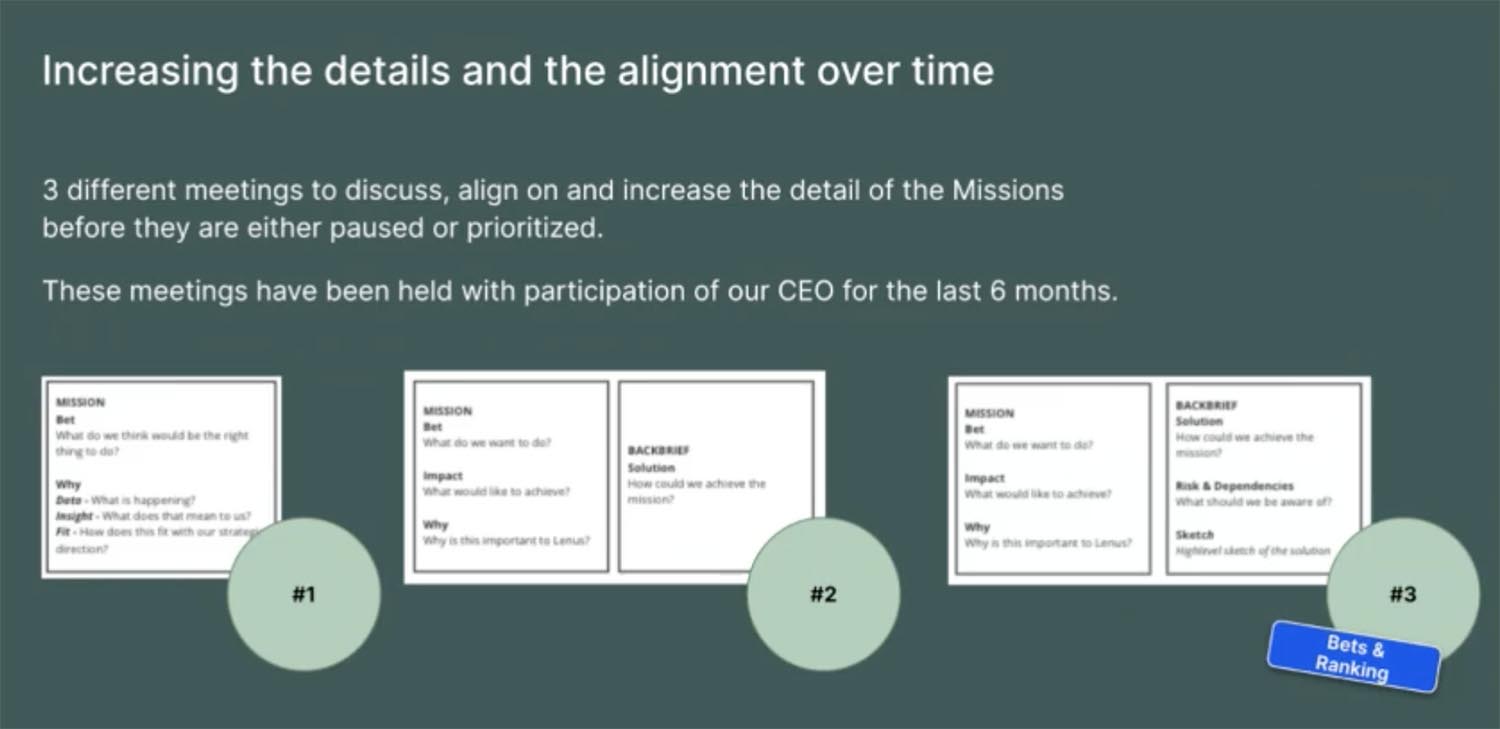
We have three different meetings where we discuss them and see the process as a funnel.
- High level missions prioritization with missions that are less detailed. We have more potential missions to discuss than what we can do.
- The first back brief meeting happens after 4 weeks, where we’ll have added more information to the whole package.. We have done more research. We have talked to more customers. We have created more prototypes to test and have looked at more data.
- Final prioritization meeting: Bets and Ranking. Finally, we have both of the artifacts ready to be prioritized. At this point, we have reduced scope and paused some of the work initially proposed, as we have then learned that some of these missions are now not relevant at this point. This meeting is called Bets and Ranking - it’s where we finally prioritize what missions to embark on.. We obviously have more missions on the table than we can actually do, so we’ll pick some of them and postpone others for another time.
In all of these meetings, we have involvement from top management. In that way, we are able to align on where we are doing and why we are doing what we’re doing - having real artifacts to talk about and discuss, which is related to what the business wants to achieve. But we also look at it from a product perspective: how can we actually do these things?
The Role of Cadence and Scope
In the pursuit of delivering valuable increments to the market and learning from them, it is essential to have a transparent process that ensures reliable delivery. At Lenus, we draw inspiration from the approaches of successful organizations such as Basecamp and Spotify in managing our workflow across the globe.
To this end, we have established fixed time periods, or cadence, in which we operate, while allowing for flexibility in scope within those time frames. This allows us to focus on shipping valuable increments and learning from the market by scoping and prioritizing work before a bets and ranking meeting.
Our approach here is inspired by two notable sources: “Shape Up,” a book written by Ryan Singer, and his team at Basecamp. The working methodology employed by Spotify as a global organization. Essentially, we establish some timewise rules or guidelines to follow. The cadence in time is fixed, but the scope within that time frame is very flexible. We prioritize shipping valuable increments, learning from the market and ensuring that we ship slices of valuable products to gain insights.
The structure of our 6 week cadance
To achieve this, we scope out work that has been prioritized in the bets and ranking meeting. We then allow ourselves six weeks to work on scoping, which becomes both an investigative process where we explore the opportunity space and a scoping process where we prioritize valuable pieces of work that can be delivered within the allotted time.
Next, we move into a five week development period where we focus on building and delivering the slice of work that we have scoped out. We may still adjust the scope if necessary, but the goal is to be ready for quality assurance after five weeks. We prioritize maintaining high quality throughout the development process and are then prepared to release the work and gather feedback.
Following this, we enter a period that we call hypercare, where we take a step back, assess other aspects of the product, and take a break from the current mission. We then move on to either tackle a new mission or continue work on the next iteration of the previous one.
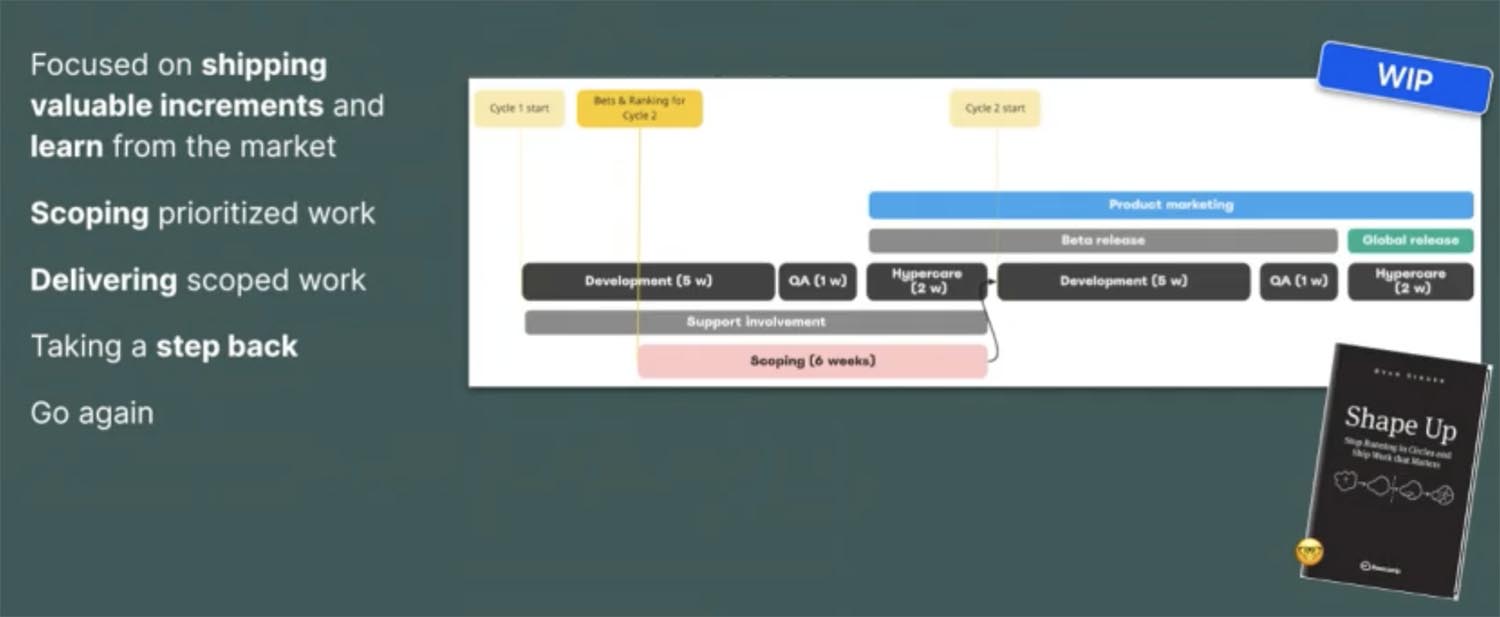
By operating in this way, with missions delivered in a set cadence and scope being managed during the work process, we are able to prioritize and focus on specific tasks. It also allows us to communicate more effectively with the rest of the organization and inform them of when they can provide input or when we are ready to move on to new work.
Benefits of a consistent and aligned cadence
Our organization has implemented a consistent cadence for our product teams. This has had a number of benefits, both in terms of our internal processes and our communication with stakeholders.
From an organizational perspective, having all teams start and stop at the same time makes it easier for us to prioritize our work and shift focus when necessary. It also helps to safeguard the team, as we are able to focus on our missions without being disturbed by external factors. This systematic and explicit approach to our work makes it easier for us to communicate with the rest of the organization and keep them informed of our progress and priorities.
The consistent cadence also allows us to hold meetings for various purposes, including prioritization and delivery, which helps us to focus our time and effort on the most important tasks. It also enables us to share ideas and identify opportunities and threats across our various teams and with the rest of the organization.
Furthermore, the consistent cadence makes it easier for us to be explicit about iterations and manage expectations. When we slice down our work and deliver smaller, valuable pieces, it becomes more visible when we need to do additional iterations due to usage or outcomes. This improved visibility and communication allows us to grow the product with the understanding and support of the rest of the organization.
Since implementing this approach, we have seen increased trust from stakeholders, a clearer understanding of our work, and an overall improvement in focus and productivity. We have also delivered more value and had more informed discussions about the direction of our product.
Of course, we are still learning and adjusting as we go, and have had regular retrospectives to identify areas for improvement. However, overall, the consistent cadence has been a valuable tool for our organization and we look forward to seeing how it will continue to benefit us in the future.
The challenges and benefits of implementing a consistent cadence
As we have been implementing a consistent cadence for our product teams, we have encountered both challenges and benefits. On the one hand, deadlines can create feelings of stress or pressure to deliver quickly, which can lead to cutting corners or sacrificing quality. However, we have also learned the importance of investing time upfront to frame and understand the business outcomes and customer needs before we prioritize our work. This helps to decrease uncertainty and increase our chances of delivering value in the long term.
Another challenge we have faced is how to find time and mindspace for mid-sized work that falls between missions and bugs. To address this, we are focusing on organizing more around coach and client journeys, which will allow us to have more flexibility in this area. We are also looking to expand ownership beyond individual domains and align our work more closely with how coaches and clients experience the product.
What we have learned so far
- Deadlines can create feelings of stress and lower quality if we’re not de-scoping enough
- Effective prioritization needs framing to limit business risk early on
- Mid-sized work is difficult to find time for when we are focused on Missions
- We (might) need to align our cycles to other parts of Lenus and their cycles
In terms of next steps, we plan to continue working with missions and cadence while also increasing our focus on the coach and client perspective. We also hope to collaborate more within the product organization around common goals and metrics. Additionally, we are looking to identify good practices for prioritization, work more on scoping, and align even more closely with the rest of the organization.
Overall, implementing a consistent cadence has been a valuable but challenging process, and we look forward to continuing to learn and adjust as we go.
Find mentors who can help you with Product Strategy
